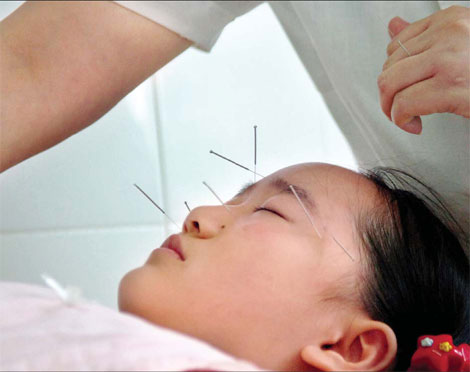Health
Seeing the point
Updated: 2010-12-15 09:37
(China Daily)
 |
|
Acupuncture is used to treat children with shortsightedness at a Hefei hospital in Anhui province. [Photo/Liu Bingsheng /China Daily] |
A new study shows acupuncture needles can help children with a 'lazy eye' but experts caution this is not a definitive conclusion.
Sticking acupuncture needles into points on the body classically associated with vision in Chinese medicine could prove to be an alternative to bothersome patches or drops for older children with a 'lazy eye', suggests new research.
Children who received needling from a certified acupuncturist saw similar improvement in their affected eyes as those who underwent the standard treatment of wearing a patch over the strong eye for a couple hours a day in order to strengthen the weak eye. Most participants in both groups advanced two lines or more on an eye chart over the course of the study.
Experts don't recommend that parents swap patches for acupuncture treatments just yet, however. Further research is needed to confirm the findings and to better understand just how the therapy works.
"Acupuncture has been used for a lot of things in Chinese medicine," says senior researcher Dr Robert Ritch of the New York Eye and Ear Infirmary. "And it's being used more and more in the West. But evidence-based medicine to see what it actually does is relatively lacking."
Up to 5 percent of people around the world suffer from amblyopia, a condition characterized by poor vision in one eye and colloquially called lazy eye. It is the most common cause of vision problems in children.
Between 30 and 50 percent of amblyopia cases are caused by differences in the degree of nearsightedness or farsightedness between the two eyes, termed anisometropic amblyopia.
The problem can be corrected with glasses or contact lenses if caught at an early age. But both are less effective for children beyond about the age of 7, who have traditionally been treated with patches.
"Patching can be annoying for kids," says Dr Matthew Gearinger of the University of Rochester, New York, who was not involved in the study. "It may be socially tough to wear a patch at school, and wearing a patch at home can interfere with homework."
Specially medicated eye drops, another common treatment, blur sight in the good eye and can also make homework difficult, Gearinger adds.
In the new study, Ritch and Chinese colleagues looked at 88 children in China between the ages of 7 and 12 who suffered from lazy eye and had already been wearing glasses for at least 16 weeks. They randomly assigned about half the children to wear a patch over the good eye for two hours every day, and the other half to attend five acupuncture sessions weekly; both groups underwent their respective treatments for up to 25 weeks.
All the children were also given new glasses to wear and asked to perform an hour of daily near-vision activities.
By the end of the 25 weeks, the researchers found that at least seven out of 10 children in each group saw their lazy eye's sight improve by at least two lines on an eye chart.
More than twice as many children who received acupuncture overcame the condition compared to those who wore an eye patch: 42 percent versus 17 percent.
While Gearinger suggests that the concept is interesting and the potential for an alternate treatment for lazy eye encouraging, he cautions that the number of children studied was small. He also notes that the treatment option may be impractical in the United States, where there are few acupuncturists with experience treating lazy eye.
Even if they were available, "it is a lot to ask parents to drive to a local acupuncturist five days a week, rather than just using drops or a patch at home", he says.
Dr Peter Lipson, of the University of Michigan, also points to some limitations of the study, including the fact that "everyone knew who was patched and who got acupuncture", which could have biased the outcomes.
Lipson, who was not involved in the work, further suggests that without an untreated group the study can't rule out the possibility that not doing anything, or simply using corrective glasses and performing daily exercises, would work just as well.
"This is not, in my opinion, evidence of acupuncture being as good as standard care, only that in this particular study children did about the same if they received standard care or non-standard care," Lipson says. "It says nothing at all about acupuncture."
The researchers speculate in the Archives of Ophthalmology that acupuncture needles placed at vision-related points on the body might work by increasing the blood flow to both the eye and brain. But they acknowledge that what lies behind acupuncture's apparent success remains unclear.
Ritch and his team are following up with more studies to improve the understanding of how acupuncture may be helpful for lazy eye.
"Don't knock Chinese medicine," Ritch says. "It's been around for more than 3,000 years and there's a lot we don't understand yet."
E-paper

Ear We Go
China and the world set to embrace the merciful, peaceful year of rabbit
Carrefour finds the going tough in China
Maid to Order
Striking the right balance
Specials

Mysteries written in blood
Historical records and Caucasian features of locals suggest link with Roman Empire.

Winning Charm
Coastal Yantai banks on little things that matter to grow

New rules to hit property market
The State Council launched a new round of measures to rein in property prices.
